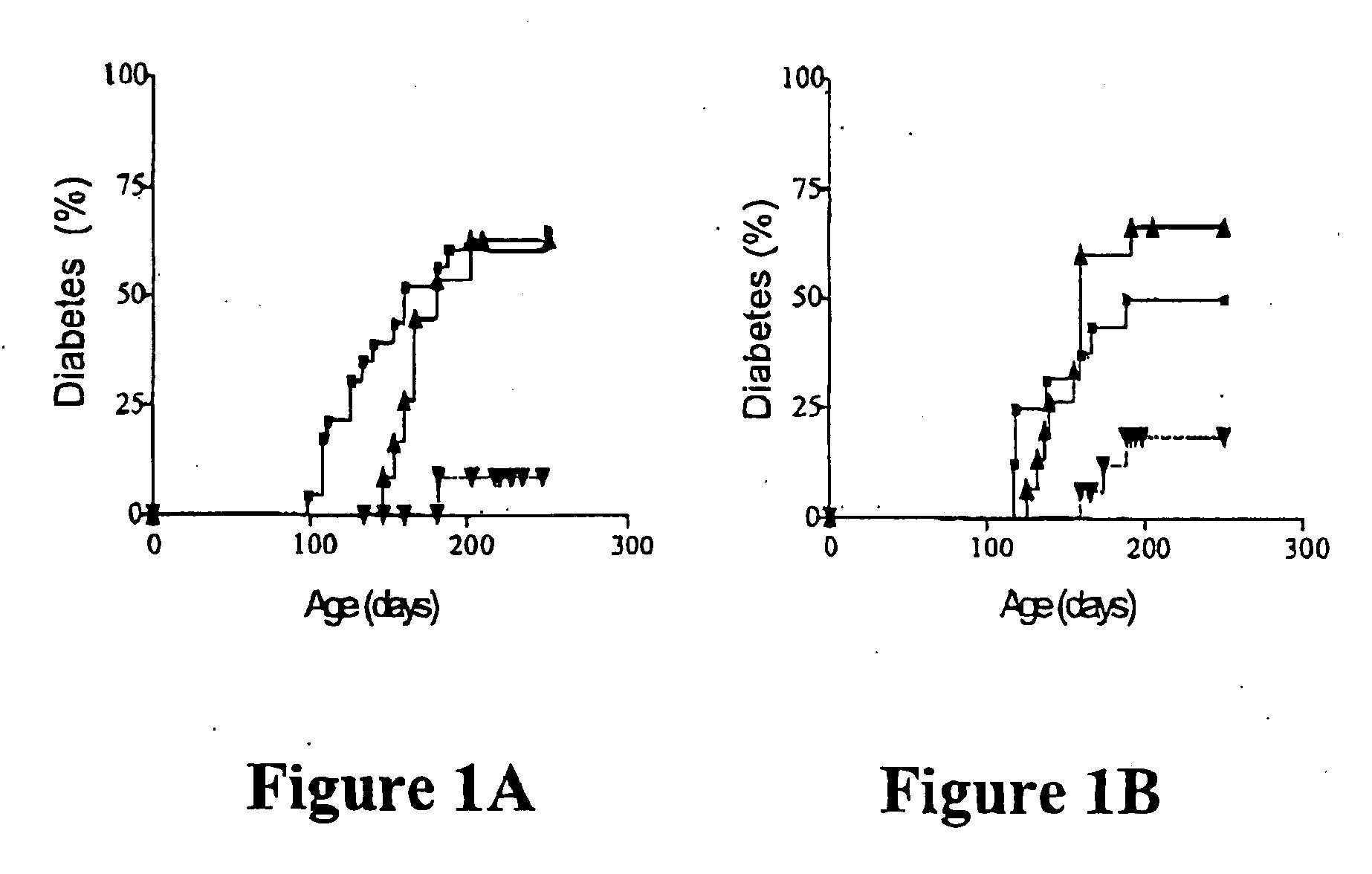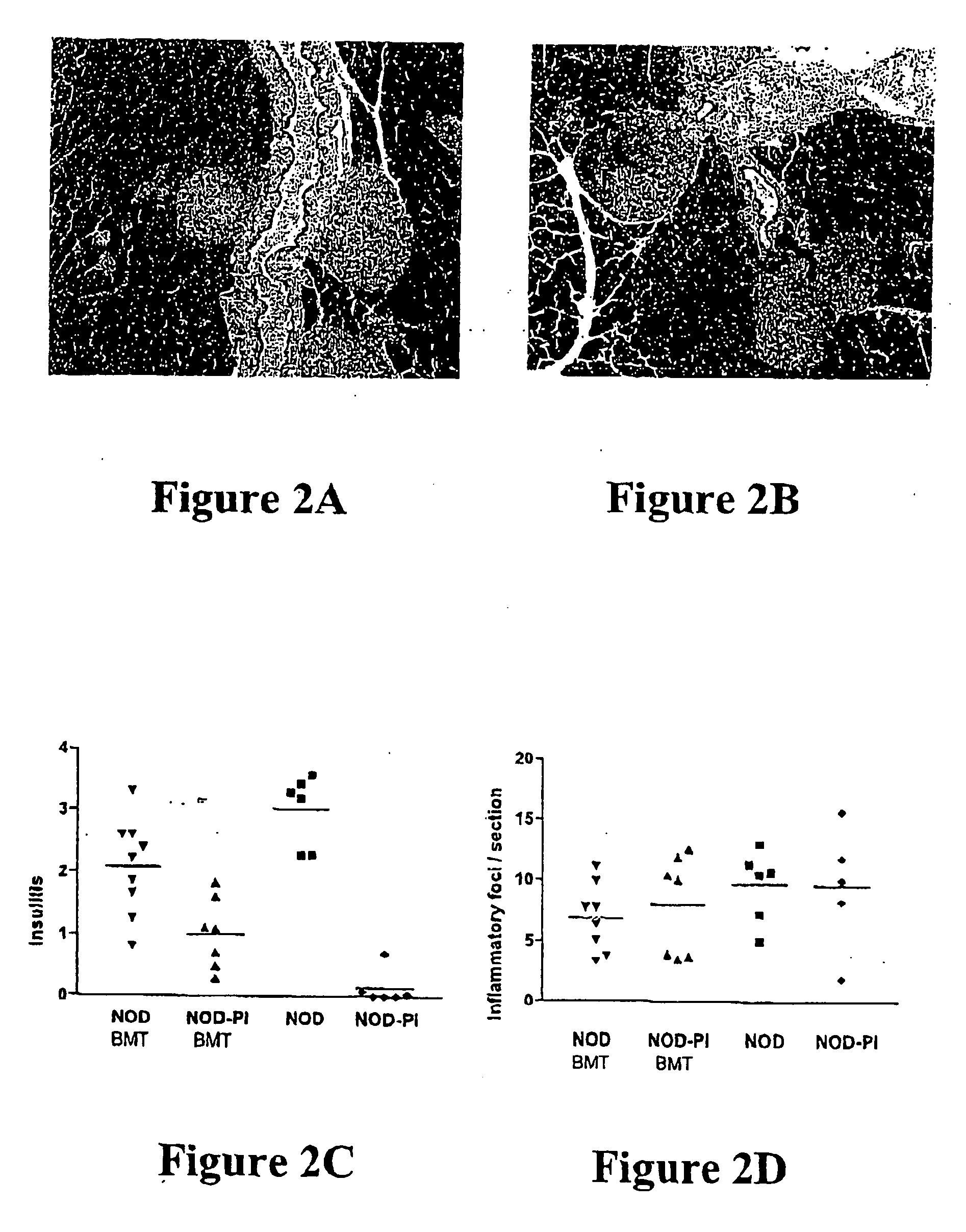Method of treating an autoimmune disease
- Summary
- Abstract
- Description
- Claims
- Application Information
AI Technical Summary
Benefits of technology
Problems solved by technology
Method used
Image
Examples
example 1
General Methods
Mice
[0069] NOD (non-obese diabetic) and NOD.scid mice were bred under specific-pathogen free conditions. NOD mice transgenic for mouse proinsulin II (NOD-PI) under control of the MHC class II (I-Eα) promoter (French et al., Diabetes 46: 34-39, 1997) were used after breeding to homozygosity. As the incidence of spontaneous diabetes is highest in wild-type NOD females, only females were used as recipients and bone marrow (BM) donors.
Antibodies and Flow Cytometry
[0070] Flow cytometric analysis was performed as described (Steptoe et al., J. Immunol. 168: 5032-5041, 2002). The following mAbs were purified from tissue culture supernatants and then used in conjugation reactions: Antibodies directed against Gr-1 (Ly-6G; RB6-8C5), F4 / 80 (F4 / 80), CD11b (5C6 or M1 / 70), CD11c (N418), MHC class II (10.2.16 [I-Ak,g7,r,f,s]), MHC class I (M1 / 42), M-CSF R (AFS-98), CD40 (FGK-45), B220 (RA3-6B2) and CD86 (GL-1) Streptavidin (SA)-fluorochrome conjugates (SA-FITC, SA-phycoerythrin...
example 2
Transplantation of NOD-PI Bone Marrow Prevents Diabetes
[0077] Whole BM from NOD or NOD-PI mice was transplanted to 4 week-old irradiated female NOD recipients. While the onset was delayed slightly, the overall incidence of diabetes in NOD BM recipients (7 / 12) was similar to untreated controls (15 / 23) (FIG. 1A). In contrast, diabetes was almost completely prevented in recipients of NOD-PI BM (1 / 16, P=0.0032) (FIG. 1A). NOD mice have an inherently high risk of thymoma development that is exacerbated by impaired immune surveillance or exposure to ionising radiation (Prochazka et al., Proc. Natl. Acad. Sci. USA 89: 3290-3294, 1992; Shultz et al., J. Immunol. 164: 2496-2507, 2000). Exclusion of mice diagnosed with thymomas at necropsy increased the proportion of mice with diabetes in both groups (NOD 7 / 10, NOD-PI 1 / 5) but the difference in diabetes incidence remained significant between groups (P±0.041). Because of their longer diabetes-free survival time, recipients of NOD-PI BM had a ...
example 3
T Cell-Depletion does not Modify the Protective Effect of Transplanted NOD-PI BM
[0078] Separate studies had found that mature T cells in NOD BM were capable of transferring diabetes to immune-deficient NOD.scid mice. Diabetes development, following transfer of whole BM, might, therefore, have reflected the diabetogenic potential of transferred mature T cells. However, it was found that, whereas whole NOD BM transferred diabetes to at least 50% of non-irradiated T cell-deficient NOD.scid mice, no mice that received BM from NOD-PI mice developed diabetes.
[0079] As mature T cells in NOD, but not NOD-PI, BM could transfer diabetes, the effect of transplanting T cell-depleted BM to irradiated 4 week-old mice was tested. Recipients of T cell depleted NOD BM developed diabetes at a rate and incidence (10 / 15) similar to untreated controls (7 / 12) (FIG. 1B). In contrast, diabetes development was significantly less (3 / 17, P=0.003) in recipients of T cell-depleted NOD-PI BM (FIG. 1B). When mi...
PUM
| Property | Measurement | Unit |
|---|---|---|
| Immunogenicity | aaaaa | aaaaa |
Abstract
Description
Claims
Application Information
 Login to View More
Login to View More - R&D
- Intellectual Property
- Life Sciences
- Materials
- Tech Scout
- Unparalleled Data Quality
- Higher Quality Content
- 60% Fewer Hallucinations
Browse by: Latest US Patents, China's latest patents, Technical Efficacy Thesaurus, Application Domain, Technology Topic, Popular Technical Reports.
© 2025 PatSnap. All rights reserved.Legal|Privacy policy|Modern Slavery Act Transparency Statement|Sitemap|About US| Contact US: help@patsnap.com



